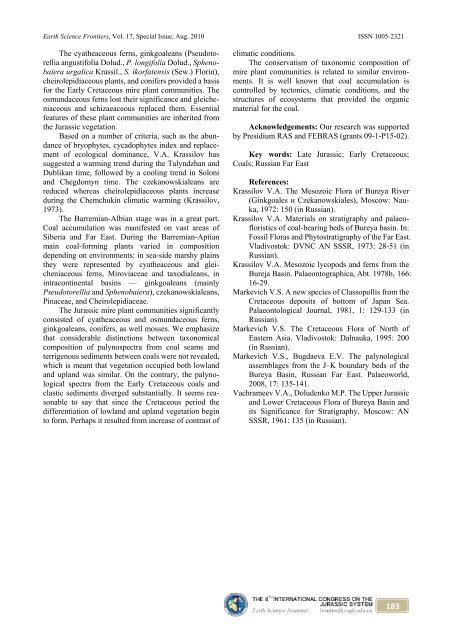in Jurassic and Cretaceous Stratigraphy
in Jurassic and Cretaceous Stratigraphy
in Jurassic and Cretaceous Stratigraphy
You also want an ePaper? Increase the reach of your titles
YUMPU automatically turns print PDFs into web optimized ePapers that Google loves.
Earth Science Frontiers, Vol. 17, Special Issue, Aug. 2010 ISSN 1005-2321<br />
The cyatheaceous ferns, g<strong>in</strong>kgoaleans (Pseudoto-<br />
rellia angustifolia Dolud., P. longifolia Dolud., Spheno-<br />
baiera urgalica Krassil., S. ikorfatensis (Sew.) Flor<strong>in</strong>),<br />
cheirolepidiaceous plants, <strong>and</strong> conifers provided a basis<br />
for the Early <strong>Cretaceous</strong> mire plant communities. The<br />
osmundaceous ferns lost their significance <strong>and</strong> gleiche-<br />
niaceous <strong>and</strong> schizaeaceous replaced them. Essential<br />
features of these plant communities are <strong>in</strong>herited from<br />
the <strong>Jurassic</strong> vegetation.<br />
Based on a number of criteria, such as the abun-<br />
dance of bryophytes, cycadophytes <strong>in</strong>dex <strong>and</strong> replace-<br />
ment of ecological dom<strong>in</strong>ance, V.A. Krassilov has<br />
suggested a warm<strong>in</strong>g trend dur<strong>in</strong>g the Talyndzhan <strong>and</strong><br />
Dublikan time, followed by a cool<strong>in</strong>g trend <strong>in</strong> Soloni<br />
<strong>and</strong> Chegdomyn time. The czekanowskialeans are<br />
reduced whereas cheirolepidiaceous plants <strong>in</strong>crease<br />
dur<strong>in</strong>g the Chemchuk<strong>in</strong> climatic warm<strong>in</strong>g (Krassilov,<br />
1973).<br />
The Barremian-Albian stage was <strong>in</strong> a great part.<br />
Coal accumulation was manifested on vast areas of<br />
Siberia <strong>and</strong> Far East. Dur<strong>in</strong>g the Barremian-Aptian<br />
ma<strong>in</strong> coal-form<strong>in</strong>g plants varied <strong>in</strong> composition<br />
depend<strong>in</strong>g on environments: <strong>in</strong> sea-side marshy pla<strong>in</strong>s<br />
they were represented by cyatheaceous <strong>and</strong> glei-<br />
cheniaceous ferns, Miroviaceae <strong>and</strong> taxodialeans, <strong>in</strong><br />
<strong>in</strong>tracont<strong>in</strong>ental bas<strong>in</strong>s — g<strong>in</strong>kgoaleans (ma<strong>in</strong>ly<br />
Pseudotorellia <strong>and</strong> Sphenobaiera), czekanowskialeans,<br />
P<strong>in</strong>aceae, <strong>and</strong> Cheirolepidiaceae.<br />
The <strong>Jurassic</strong> mire plant communities significantly<br />
consisted of cyatheaceous <strong>and</strong> osmundaceous ferns,<br />
g<strong>in</strong>kgoaleans, conifers, as well mosses. We emphasize<br />
that considerable dist<strong>in</strong>ctions between taxonomical<br />
composition of palynospectra from coal seams <strong>and</strong><br />
terrigenous sediments between coals were not revealed,<br />
which is meant that vegetation occupied both lowl<strong>and</strong><br />
<strong>and</strong> upl<strong>and</strong> was similar. On the contrary, the palyno-<br />
logical spectra from the Early <strong>Cretaceous</strong> coals <strong>and</strong><br />
clastic sediments diverged substantially. It seems rea-<br />
sonable to say that s<strong>in</strong>ce the <strong>Cretaceous</strong> period the<br />
differentiation of lowl<strong>and</strong> <strong>and</strong> upl<strong>and</strong> vegetation beg<strong>in</strong><br />
to form. Perhaps it resulted from <strong>in</strong>crease of contrast of<br />
climatic conditions.<br />
The conservatism of taxonomic composition of<br />
mire plant communities is related to similar environ-<br />
ments. It is well known that coal accumulation is<br />
controlled by tectonics, climatic conditions, <strong>and</strong> the<br />
structures of ecosystems that provided the organic<br />
material for the coal.<br />
Acknowledgements: Our research was supported<br />
by Presidium RAS <strong>and</strong> FEBRAS (grants 09-1-P15-02).<br />
Key words: Late <strong>Jurassic</strong>; Early <strong>Cretaceous</strong>;<br />
Coals; Russian Far East<br />
References:<br />
Krassilov V.A. The Mesozoic Flora of Bureya River<br />
(G<strong>in</strong>kgoales и Czekanowskiales), Moscow: Nau-<br />
ka, 1972: 150 (<strong>in</strong> Russian).<br />
Krassilov V.A. Materials on stratigraphy <strong>and</strong> palaeo-<br />
floristics of coal-bear<strong>in</strong>g beds of Bureya bas<strong>in</strong>. In:<br />
Fossil Floras <strong>and</strong> Phytostratigraphy of the Far East.<br />
Vladivostok: DVNC AN SSSR, 1973: 28-51 (<strong>in</strong><br />
Russian).<br />
Krassilov V.A. Mesozoic lycopods <strong>and</strong> ferns from the<br />
Bureja Bas<strong>in</strong>. Palaeontographica, Abt. 1978b, 166:<br />
16-29.<br />
Markevich V.S. A new species of Classopollis from the<br />
<strong>Cretaceous</strong> deposits of bottom of Japan Sea.<br />
Palaeontological Journal, 1981, 1: 129-133 (<strong>in</strong><br />
Russian).<br />
Markevich V.S. The <strong>Cretaceous</strong> Flora of North of<br />
Eastern Asia. Vladivostok: Dalnauka, 1995: 200<br />
(<strong>in</strong> Russian).<br />
Markevich V.S., Bugdaeva E.V. The palynological<br />
assemblages from the J–K boundary beds of the<br />
Bureya Bas<strong>in</strong>, Russian Far East. Palaeoworld,<br />
2008, 17: 135-141.<br />
Vachrameev V.A., Doludenko M.P. The Upper <strong>Jurassic</strong><br />
<strong>and</strong> Lower <strong>Cretaceous</strong> Flora of Bureya Bas<strong>in</strong> <strong>and</strong><br />
its Significance for <strong>Stratigraphy</strong>. Moscow: AN<br />
SSSR, 1961: 135 (<strong>in</strong> Russian).<br />
183

















